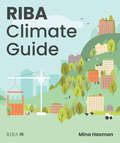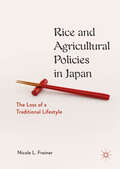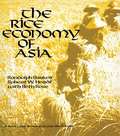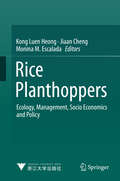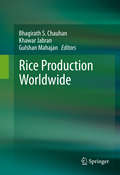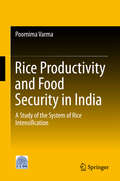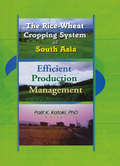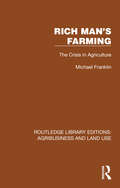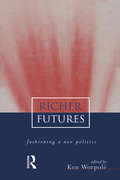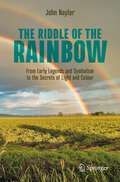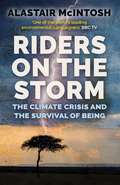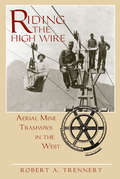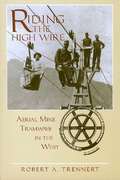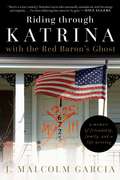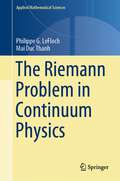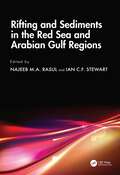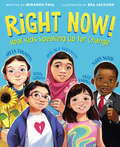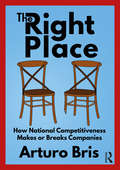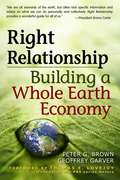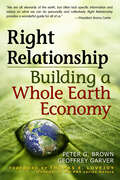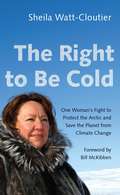- Table View
- List View
RIBA Climate Guide
by Mina HasmanClimate change is a threat to humankind, which requires immediate action. The built environment has a vital role to play in responding to the climate emergency. There is a pressing need for architects to acquire the requisite skills and knowledge to design buildings that deliver sustainable outcomes, meeting the RIBA 2030 Climate Challenge and mandatory competence in climate literacy. Equipping you with the key information that built environment professionals require to halt climate change and mitigate its impacts in your day-to-day work, this book is organised around six overarching topics: 1. Human Factors 2.Circular Economy 3.Energy and Carbon 4.Water 5.Ecology and Biodiversity 6.Connectivity and Transport Featuring images and original illustrations, each themed section will guide you through fundamental elements and competencies for creating a sustainable design and delivery framework that can be implemented by you in your practice. Contextualising the climate emergency within the built environment landscape, the guide maps out the essential background knowledge around climate science, international agreements, legislations, commitments and roadmaps. A collection of short, building- and urban-scale case studies present key takeaways, illustrating real-life applications of design strategies and industry-wide tools, as well as standards that are deployed in climate-conscious built environments all around the world.
Rice
by Francesca Bray Peter A. Coclanis Edda L. Fields-Black Dagmar Schäfer Francesca Bray Peter A. Coclanis Edda L. Fields-BlackRice today is food to half the world's population. Its history is inextricably entangled with the emergence of colonialism, the global networks of industrial capitalism, and the modern world economy. The history of rice is currently a vital and innovative field of research attracting serious attention, but no attempt has yet been made to write a history of rice and its place in the rise of capitalism from a global and comparative perspective. Rice is a first step toward such a history. The fifteen chapters, written by specialists on Africa, the Americas, and several regions of Asia, are premised on the utility of a truly international approach to history. Each one brings a new approach that unsettles prevailing narratives and suggests new connections. Together they cast new light on the significant roles of rice as crop, food, and commodity and shape historical trajectories and interregional linkages in Africa, the Americas, Europe, and Asia.
Rice and Agricultural Policies in Japan: The Loss Of A Traditional Lifestyle
by Nicole L. FreinerThis book chronicles Japan’s rice farmers who live in mainly rural areas in the west and south of Japan through original interviews conducted in Japanese. It argues that current agricultural policy as well as the tightening relationship between the US and Japan is a death sentence for a traditional lifestyle that is vital to Japan’s notion of national identity. The project covers recent agricultural policies, including the Trans-Pacific Partnership (TPP) agreement and its potential consequences on Japan’s food sovereignty and documents the effect of these policies on rice farmers. This volume is ideal for those interested in Japan’s agricultural policies and rural and traditional Japanese lifestyle.
The Rice Crisis: Markets, Policies and Food Security
by David DaweThe recent escalation of world food prices – particularly for cereals - prompted mass public indignation and demonstrations in many countries, from the price of tortilla flour in Mexico to that of rice in the Philippines and pasta in Italy. The crisis has important implications for future government trade and food security policies, as countries re-evaluate their reliance on potentially more volatile world markets to augment domestic supplies of staple foods. This book examines how government policies caused and responded to soaring world prices in the particular case of rice, which is the world's most important source of calories for the poor. Comparable case studies of policy reactions in different countries, principally across Asia, but also including the USA, provide the understanding necessary to evaluate the impact of trade policy on the food security of poor farmers and consumers. They also provide important insights into the concerns of developing countries that are relevant for future international trade negotiations in key agricultural commodities. As a result, more appropriate policies can be put in place to ensure more stable food supplies in the future. Published with the Food and Agriculture (FAO) Organization of the United Nations
The Rice Economy of Asia
by Randolph Barker Robert W. Herdt Beth RoseTo millions of people in the world, rice is the center of existence, especially in Asia, where more than 90 percent of the world's rice is grown. This book is about the trends and changes that have occurred in the Asian rice economy since World War II, but particularly since the introduction of new varieties of rice and modern technology in the mid-1960s. Although there is now a vast amount of literature and statistical data on various aspects of the subject, no single comprehensive treatment has previously been prepared. The Rice Economy of Asia not only provides such a treatment but also presents a clear picture of some of the critical issues dealing with productivity and equity --- as a glance at the table of contents will show. In addition to 18 chapters, there are an extensive bibilography, 150 tables, and 50 charts. The volume, as a whole, should be interesting and useful to decisionmakers at national and international levels, to professionals, and to students of development.
Rice Planthoppers
by Kong Luen Heong Jiaan Cheng Monina M. EscaladaThe book discusses planthopper pests of rice. These insects are one of the most destructive pests, threatening food security around the world. The historical development of the rice planthopper problem shows that they are secondary pests and single-discipline control tactics or strategies were not able to manage them, and instead caused frequent resurgences. This book not only presents new approaches to this persistent problem, but also new ecological methods, new perspectives on the effect of pesticide marketing, insights into developing resistant varieties and structural reforms in pest management. Integrating biological, ecological, economic and sociological aspects, it clearly presents the latest information on newly developed strategies for managing this pest. Dr. K. L. Heong is the principal scientist and insect ecologist at the International Rice Research Institute, Philippines. He has been researching rice planthoppers for more than 30 years. Dr. Heong is a fellow of the Third World Academy of Science and the Academy of Sciences, Malaysia. Professor Jia-an Cheng is an insect ecologist who has been studying rice planthoppers for about 50 years. He is a professor at Zhejiang University, China. Professor M. M. Escalada works at Visayas State University.
Rice Production Worldwide
by Bhagirath S. Chauhan Khawar Jabran Gulshan MahajanThis book addresses aspects of rice production in rice-growing areas of the world including origin, history, role in global food security, cropping systems, management practices, production systems, cultivars, as well as fertilizer and pest management. As one of the three most important grain crops that helps to fulfill food needs all across the globe, rice plays a key role in the current and future food security of the world. Currently, no book covers all aspects of rice production in the rice-growing areas of world. This book fills that gap by highlighting the diverse production and management practices as well as the various rice genotypes in the salient, rice-producing areas in Asia, Europe, Africa, the Americas, and Australia. Further, this text highlights harvesting, threshing, processing, yields and rice products and future research needs. Supplemented with illustrations and tables, this text is essential for students taking courses in agronomy and production systems as well as for agricultural advisers, county agents, extension specialists, and professionals throughout the industry.
Rice Productivity and Food Security in India
by Poornima VarmaThis book contributes to the adoption of agricultural technology in general and to literature on the System of Rice Intensification (SRI) in particular by identifying the factors that influence the decision to adopt SRI and examining SRI's impact on household income and yield. The study also discusses the importance of SRI in achieving higher rice productivity and food security. Conducted on behalf of the Government of India's Ministry of Agriculture from October 2014 to March 2016, the study collected detailed and extensive household-level data. As the second largest producer and consumer, India plays an important role in the global rice economy. Food security in India has been traditionally defined as having a sufficient supply of rice at an affordable price. However, in recent years rice cultivation in India has suffered from several interrelated problems. Increased yields achieved during the green revolution period and with the help of input-intensive methods involving high water and fertiliser use are now showing signs of stagnation and concomitant environmental problems due to salinisation and waterlogging of fields. Water resources are also limited; as such, water for irrigation must contend with increasing industrial and urban needs. As a result of all these factors, rice farmers have experienced a downturn in productivity growth. Since increasing the area of rice cultivation is not feasible, the additional production has to be achieved using less land, less water and fewer additional inputs. The new intensification methods for rice cultivation known as the System of Rice Intensification (SRI), which originated in Madagascar, offer a promising systemic approach to enhancing rice production at affordable costs by simultaneously reducing input requirements and causing less harm to the environment. The SRI approach is expected to enhance yield and substantially reduce water and other input requirements by altering plant, soil, water and nutrient management practices. With SRI taking firm root in India, the book examines and analyses the adoption and the economic impact of SRI in three major rice producing States of India: Karnataka, Madhya Pradesh and Orissa.
The Rice-Wheat Cropping System of South Asia: Efficient Production Management
by Palit Kataki Suresh Chandra BabuThe lives of more than a billion people depend on the answer!This valuable book surveys the problems of the rice-wheat cropping system practiced on the Indo-Gangetic Plain (IGP). Introduced at the time of the Green Revolution, it transformed agriculture and produced thirty years of bumper crops. The Rice-Wheat Cropping System of South Asia: Efficient Production Management offers scientific analysis of the aftereffects of this intense cropping. The Rice-Wheat Cropping System of South Asia: Efficient Production Management focuses on the questions of soil depletion, pest infestation, and soil alkalinity as elements of declining productivity. Along with clear charts, maps, and graphs, it provides practical suggestions for improving and maintaining the productivity of this irreplaceable farmland. The Rice-Wheat Cropping System of South Asia looks at the problems that have arisen for both the rice and wheat phases, including: depletion of micronutrients degradation of major nutrients from unbalanced fertilization practices infestations of nematodes increasing soil alkalinity as a result of irrigationIt also suggests solutions for maintaining productivity, including: integrated pest management sustainable agriculture micronutrient fertilizersThis informative book and its companion volume, The Rice-Wheat Cropping System of South Asia: Trends, Constraints, Productivity and Policy, are essential planning tools for agronomists, policymakers, and agroeconomists. It is also a useful reference for anyone interested in the problems of famine and intensive cropping not only in South Asia but in the world.
Rich Man's Farming: The Crisis in Agriculture (Routledge Library Editions: Agribusiness and Land Use #10)
by Michael FranklinOriginally published in 1988, this book was written at a time of excessive budgetary costs, huge surpluses and damaging trade conflicts. This study examines why a crisis situation was allowed to develop, nd proposes the most effective ways, both nationally and internationally – to chieve more rational agricultural support and trade policies. It concentrates on the efforts to reform the Common Agricultural Policy in the EU, on United States support policies, and on the GATT negotiations.
Rich World, Poor World (Routledge Library Editions: Development)
by Geoffrey LeanThis reissue, first published in 1978, confronts a whole range of international development issues: hunger, energy, supply, population growth, pollution, the state of the cities, nuclear proliferation. Geoffrey Lean explains the interdependent contemporary crises within developing nations and presents the facts behind them, alongside the practical solutions, new strategies and fresh thinking present in contemporary development thinking.
Richer Futures: Fashioning a new politics (Earthscan Library Collection: Environmental And Resource Economics Set Ser.)
by Ken WorpoleIn every area of life, traditional, centralized party politics has been failing and the seeds of a new form of political life are being sown. This is true in housing, health, education, consumption and transport, where public policy is attracting increasing criticism. In an age of social alienation and urban despondency Richer Futures is a timely response to the growing interest in community-based, self-help action. It introduces new forms of communication and decision-making and sets out a programme for a sustainable politics.Contributions from some of the best-known thinkers and writers on contemporary urban, cultural and social policy (and campaigns) in Britain today pay tribute to the ideas and industrious activities of the influential writer and commentator Colin Ward. This uplifting collection of essays looks forward to a new politics of self-management and environmentally aware and sustainable lifestyles.Ken Worpole has written a number of books on urban and cultural policy, and a series of influential reports for Comedia, Demos and the Department of the Environment.Originally published in 1999
The Riddle of the Rainbow: From Early Legends and Symbolism to the Secrets of Light and Colour (Copernicus Books)
by John NaylorRainbows have been a source of fascination since time immemorial. They have been the subject of myth and superstition, an inspiration to poets, a challenge to painters, the object of intense scientific interest and a touchstone for ideas about the nature of light and colour. Above all, the rainbow has been the embodiment of wonder from the earliest times to the present day.Beginning with the circumstances in which you are likely to see a rainbow and descriptions of its salient features, this book recounts and explains the myths and superstitions about rainbows, and describes how poets, painters and, above all, leading scientists in every age have sought to discover and understand the rainbow’s secrets.Readers with a love of nature and art and an interest in the history of science will enjoy this attractive and informative book.
Riders on the Storm: The Climate Crisis and the Survival of Being
by Alastair McIntoshA journey into science and spirituality to help us reconnect with soil, soul, and society from “one of the world’s leading environmental campaigners” (BBC TV).Climate change is the greatest challenge to humankind today. While the coronavirus sheds a light on the vulnerability of our interconnected world, the effects of global warming will be permanent, indeed catastrophic, without a massive shift in human behavior.Writer, scholar and broadcaster Alastair McIntosh sums up the present knowledge and shows that conventional solutions are not enough. In rejecting the blind alleys of climate change denial, exaggeration and false optimism, he offers a scintillating discussion of ways forward. Weaving together science, politics, psychology and spirituality, this guide examines what it takes to make us riders on the storm.“A climate primer for our times.” —Michael E. Mann, author of The New Climate War“A profusion of ideas, insight, honesty and wit.” —The Herald“Imbued with the deepest hope for a better world.” —Sir Jonathon Porritt, author of Hope in Hell“Solid on the science yet dedicated to the human spirit.” —Professor Katharine Hayhoe, Chief Scientist, The Nature Conservancy
Riding the High Wire: Aerial Mine Tramways in the West
by Robert A. TrennertRiding the High Wire is the first comprehensive history of aerial mine tramways in the American West, describing their place in the evolution of mining after 1870. Robert A. Trennert shows how the mid-nineteenth century development of wire rope manufacturing made it possible for American entrepreneurs such as Andrew S. Hallidie and Charles Huson to begin erecting single-rope tramways in the 1870s and 1880s. Their inventions were followed by the more substantial double-rope systems imported from Europe. By the turn of the century, aerial tramways were common throughout western mining regions, hauling everything from gold and silver ore to coal and salt and changing the face of the industry. Aerial mine tramways proved to have a special fascination; people often rode them for a thrill, sometimes with disastrous results. They were also very temperamental, needed constant attention, and were prone to accidents. The years between 1900 and 1920 saw the operation of some of the west's most spectacular tramways, but the decline in high-country mining beginning in the 1920s--coupled with the development of more efficient means of transportation--made this technology all but obsolete by the end of the Second World War. Historians and the general reader will be equally enthralled by Trennert's fascinating story of the rise and fall of aerial mine tramways. "Professor Trennert has explored a new area of mining history, and is to be commended for his pioneering work." --Liston Leyendecker, author of The Griffith Family and the Founding of Georgetown.
Riding the High Wire
by Robert A. TrennertRiding the High Wire is the first comprehensive history of aerial mine tramways in the American West, describing their place in the evolution of mining after 1870. Robert A. Trennert shows how the mid-nineteenth century development of wire rope manufacturing made it possible for American entrepreneurs such as Andrew S. Hallidie and Charles Huson to begin erecting single-rope tramways in the 1870s and 1880s. Their inventions were followed by the more substantial double-rope systems imported from Europe. By the turn of the century, aerial tramways were common throughout western mining regions, hauling everything from gold and silver ore to coal and salt and changing the face of the industry. Aerial mine tramways proved to have a special fascination; people often rode them for a thrill, sometimes with disastrous results. They were also very temperamental, needed constant attention, and were prone to accidents. The years between 1900 and 1920 saw the operation of some of the west's most spectacular tramways, but the decline in high-country mining beginning in the 1920s--coupled with the development of more efficient means of transportation--made this technology all but obsolete by the end of the Second World War. Historians and the general reader will be equally enthralled by Trennert's fascinating story of the rise and fall of aerial mine tramways.
Riding through Katrina with the Red Baron's Ghost: A Memoir of Friendship, Family, and a Life Writing
by J. Malcolm GarciaThe first book that J. Malcolm Garcia ever bought would impact his life in a way that the then twelve-year-old could have never imagined. The Day the Red Baron Died plunged Garcia into the intrigue and excitement of the World War I German flying ace's life and death. Garcia was enraptured and brimming with questions. His mother encouraged the curious boy to write to the book's author, Dale M. Titler. When the author replied, a friendship began that shaped Garcia's life. In Riding through Katrina with the Red Baron's Ghost, Garcia chronicles his relationship with Titler. It was that connection that brought Garcia to New Orleans only two weeks after Hurricane Katrina devastated the city and its citizens. Not having heard from his friend in years, Garcia made the split-second decision to go to New Orleans to try to find the man who meant so much to him. A harrowing account of New Orleans directly after Katrina?told in Garcia's award-winning journalistic style?Riding through Katrina with the Red Baron's Ghost tells a personal story of a thirty-year bond that defined a young man, as well as the universal story of the horror and devastation Katrina left in its wake.
The Riemann Problem in Continuum Physics (Applied Mathematical Sciences #219)
by Philippe G. LeFloch Mai Duc ThanhThis monograph provides a comprehensive study of the Riemann problem for systems of conservation laws arising in continuum physics. It presents the state-of-the-art on the dynamics of compressible fluids and mixtures that undergo phase changes, while remaining accessible to applied mathematicians and engineers interested in shock waves, phase boundary propagation, and nozzle flows. A large selection of nonlinear hyperbolic systems is treated here, including the Saint-Venant, van der Waals, and Baer-Nunziato models. A central theme is the role of the kinetic relation for the selection of under-compressible interfaces in complex fluid flows. This book is recommended to graduate students and researchers who seek new mathematical perspectives on shock waves and phase dynamics.
Rifting and Sediments in the Red Sea and Arabian Gulf Regions
by Rasul, Najeeb M.A. Stewart, Ian C.F.Rifting and Sediments in the Red Sea and Arabian Gulf Regions is a unique text that covers a wide range of topics related to the tectonics and geology of the Red Sea and Arabian (Persian) Gulf region. This book is a collection of invited and peer-reviewed chapters contributed by active researchers around the world.The topics covered in this book include tectonics, magmatism, and lithology, particularly in the Red Sea area. The book also delves into the sediments and evaporites of the Red Sea and Gulf. As the area around the Arabian Peninsula is prone to earthquakes, the seismic hazard estimated in the Red Sea region is also covered by several chapters. Each chapter presents new data and offers extensive lists of references for the reader to explore further.With the ongoing debates regarding the structure of the Red Sea, this book serves as an excellent resource for researchers and any individuals interested in the geology of these two unique seas.
Rifts and Passive Margins
by Michal NemčokRifts and passive margins are extremely important for the petroleum industry, as they are areas of high sedimentation and can contain significant oil and gas resources. This book provides a comprehensive understanding of rifts and passive margins as a whole. It synthesises in one volume the existing information devoted to specific aspects of these vitally important hydrocarbon habitats. This collecting together of state-of-the-art information on the topic facilitates the better use of this knowledge to assess the risks of exploring and operating in these settings and the development of systematic and predictive hydrocarbon screening tools. The book will be invaluable for a broad range of readers, from advanced geology students and researchers to exploration geoscientists to exploration managers exploring for and developing hydrocarbon resources in analogous settings.
Right Now!: Real Kids Speaking Up for Change
by Miranda PaulA joyful, inspiring picture book that introduces readers to eleven young people from around the world who didn&’t wait until they were grown to speak up about things that matter to them and change the world for the better, from an award-winning author and New York Times best-selling illustrator.From climate activist Greta Thunberg to anti-bullying advocate Jaylen Arnold to peace activist Bana Alabed and more, these short profiles of young people and their causes will inspire readers to think about what matters most to them. An author's note, Actions to Make a Difference, and additional resources are also included, providing a roadmap for any kid who wants to make change and help others too.
The Right Place: How National Competitiveness Makes or Breaks Companies
by Arturo BrisThe Right Place explains why firms succeed in one country and fail in another, irrespective of their inner drivers, and suggests potential initiatives that governments can take to help the private sector create jobs and, consequently, make their countries more prosperous. The competitiveness race is not unlike a cycling race. If you want to ride fast, you need three things: a good bike, to be in good shape, and a smooth and fast road. In a collaborative model, you might say the business is the bicycle, the business leader is the cyclist, and the road is the government and the external environment. The responsibility of a government is to design and build the best possible road. It turns out that when the road is good, good cyclists suddenly appear and want to race on it. In this book, competition and macroeconomics expert, Arturo Bris, provides the analysis of country competitive performance based on 30 years advising countries on this topic. The typical mistakes that countries make are revealed and the pillars necessary in building a competitive economy: economic performance as a necessary condition for prosperity; government efficiency, so the public sector can create the conditions for a productive economy; business efficiency, so companies can create jobs; and infrastructure, both tangible and intangible, so businesses and individuals can operate efficiently. With contemporary case studies throughout, the book provides an illuminating read for politicians, business leaders and students of macroeconomics.
Right Relationship: Building a Whole Earth Economy
by Peter G. Brown Geoffrey GarverOur current economic system is unsustainable. Its fundamental elements, unlimited growth, and endless wealth accumulation fly in the face of the fact that the Earth's resources are clearly finite.
Right Relationship: Building a Whole Earth Economy
by Peter G. Brown Geoffrey Garver&“We are all stewards of the earth, but often lack specific information and advice on what we can do . . . [This] provides a wonderful guide for all of us.&” —President Jimmy Carter Our current economic system—which assumes endless growth and limitless potential wealth—flies in the face of the fact that the earth&’s resources are finite. The result is increasing destruction of the natural world and growing, sometimes lethal, tension between rich and poor, global north and south. Trying to fix problems piecemeal is not the solution. We need a comprehensive new vision of an economy that can serve people and all of life&’s commonwealth. Peter G. Brown and Geoffrey Garver use the core Quaker principle of &“right relationship&”—interacting in a way that is respectful to all and that aids the common good—as the foundation for a new economic model. Right Relationship poses five basic questions: What is an economy for? How does it work? How big is too big? What&’s fair? And how can it best be governed? Brown and Garver expose the antiquated, shortsighted, and downright dangerous assumptions that underlie our current answers to these questions, as well as the shortcomings of many current reform efforts. They propose new answers that combine an acute awareness of ecological limits with a fundamental focus on fairness and a concern with the spiritual, as well as material, well-being of the human race. Brown and Garver describe new forms of global governance that will be needed to get and keep the economy in right relationship. Individual citizens can and must play a part in bringing this relationship with life and the world into being
The Right to Be Cold: One Woman's Fight to Protect the Arctic and Save the Planet from Climate Change
by Sheila Watt-CloutierA &“courageous and revelatory memoir&” (Naomi Klein) chronicling the life of the leading Indigenous climate change, cultural, and human rights advocate For the first ten years of her life, Sheila Watt-Cloutier traveled only by dog team. Today there are more snow machines than dogs in her native Nunavik, a region that is part of the homeland of the Inuit in Canada. In Inuktitut, the language of Inuit, the elders say that the weather is Uggianaqtuq—behaving in strange and unexpected ways. The Right to Be Cold is Watt-Cloutier&’s memoir of growing up in the Arctic reaches of Quebec during these unsettling times. It is the story of an Inuk woman finding her place in the world, only to find her native land giving way to the inexorable warming of the planet. She decides to take a stand against its destruction.The Right to Be Cold is the human story of life on the front lines of climate change, told by a woman who rose from humble beginnings to become one of the most influential Indigenous environmental, cultural, and human rights advocates in the world. Raised by a single mother and grandmother in the small community of Kuujjuaq, Quebec, Watt-Cloutier describes life in the traditional ice-based hunting culture of an Inuit community and reveals how Indigenous life, human rights, and the threat of climate change are inextricably linked. Colonialism intervened in this world and in her life in often violent ways, and she traces her path from Nunavik to Nova Scotia (where she was sent at the age of ten to live with a family that was not her own); to a residential school in Churchill, Manitoba; and back to her hometown to work as an interpreter and student counselor. The Right to Be Cold is at once the intimate coming-of-age story of a remarkable woman, a deeply informed look at the life and culture of an Indigenous community reeling from a colonial history and now threatened by climate change, and a stirring account of an activist&’s powerful efforts to safeguard Inuit culture, the Arctic, and the planet.
